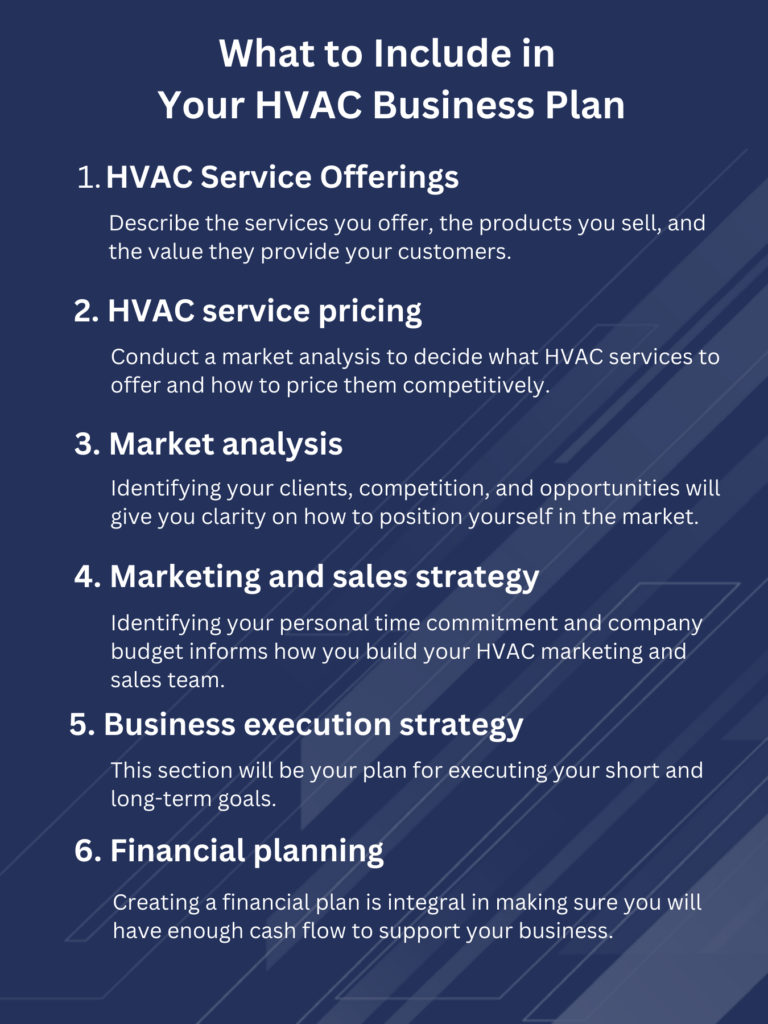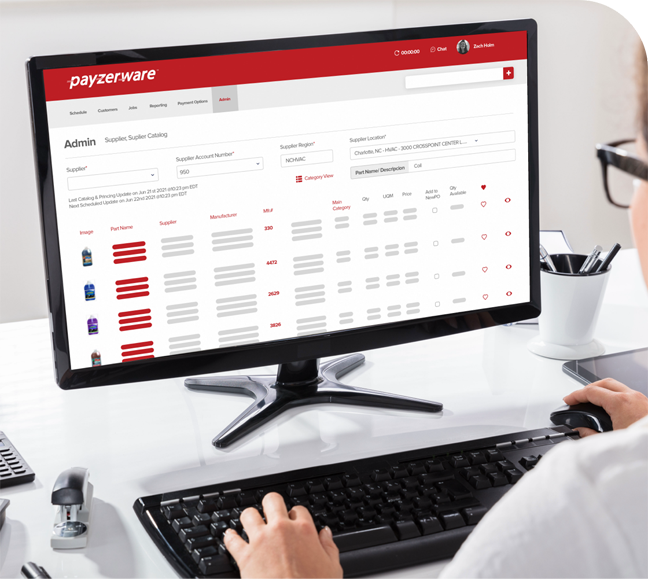A business plan is crucial for the growth and success of your HVAC company. It helps you identify your current positioning, your future business trajectory, and a plan that outlines how you’re going to get there.
There are six key components of a successful HVAC business plan:
- HVAC service offerings
- HVAC service pricing
- Market analysis
- Marketing and sales strategy
- Business execution strategy
- Financial planning
The following information will provide insights and tips for HVAC business owners to complete your own business plan. This business plan will give you an execution strategy to start your HVAC business, as well as, help you secure funding.
Grow Your HVAC Business With Payzerware
Before Writing Your HVAC Business Plan
Before you begin, you should already have your HVAC business name, logo, company contact information, location, and key stakeholders. This information will help you construct your business summary. Your business summary needs to clearly state your mission, vision, and the value props that make your company unique.
Once you finalize the key foundations and your business summary you can begin writing your HVAC business plan.
The 6 Key Components Of A Successful HVAC Business Plan

1. HVAC Service Offerings
This section describes the services you offer, the products you sell, and the value they provide your customers.
Examples of HVAC Service Offerings:
- HVAC Maintenance Agreements
- Air conditioning installation and repair
- Furnace installation and repair
- Water heater installation and repair
- Emergency HVAC services
You should also evaluate operating exclusively in heating and cooling or offering additional services like; refrigeration, plumbing, insulation, and air quality. With proper tools and training these additional services can be an additional income driver. Diversification of services can be especially important during the slow season of HVAC (October – April).
Depending on your service offerings your customers could receive the following benefits:
- Reduced energy costs
- Improved air quality
- Indoor moisture control
- Improved home value
- Increased safety and protection
Analyze the market in your area to decide the best HVAC services to provide.
2. HVAC Service Pricing
Deciding on the right HVAC services to provide is only the beginning. Your services need to be priced competitively for your market. Your pricing will set the stage for your projected profitability and future growth.
Two main pricing models exist in the HVAC industry:
- Standard pricing model – calculated using time and materials.
- HVAC flat rate pricing – charges a set price regardless of the time commitment.
Pros and cons exist with each pricing method.
The pro of a standard pricing model is that if a job takes longer than expected, each additional hour is accounted for. However, the con is that this model may encourage delays with technicians and can provoke more questions from customers.
The pros of HVAC flat rate pricing is that it provides transparency to the customer and can minimize price discrepancy questions. Alternatively, if a job takes longer than expected you risk losing out on additional compensation. HVAC flat rate pricing would be beneficial for a team of experienced HVAC technicians who are efficient and effective.
Conduct a market analysis to decide what HVAC services to offer and how to price them competitively.
3. Market Analysis
A market analysis is the key to gaining a competitive advantage and should answer the following questions:
- Who is your target market/ideal client? What is their age, income, and socioeconomic status?
- What are your target market’s pain points?
- Who is your competition?
- What are your competition’s strengths and weaknesses?
- What services do your competition offer?
- How is your competition pricing their services?
- Should you service residential, commercial, or a combination of both>
It’s important to be as detailed as possible in your market analysis. Identifying your clients, competition, and opportunities will give you clarity on how to position yourself in the market.
Once you have this information you can begin developing your marketing strategy.
4. HVAC Marketing Plan and Sales Strategy
Now you know your services, pricing, audience, positioning, and competitive advantage. The next step is acquiring high-converting leads.
Before developing your marketing and sales strategy you should answer the following questions:
- Do you have an experienced and trustworthy sales representative who can drive results?
- As an owner, do you personally want to be more involved with the acquisition, day-to-day operations, or neither?
- Do you have an experienced and trustworthy marketing professional who can drive results?
- What are your competitors’ marketing and sales strategies?
- What is your budget for marketing and sales?
At a minimum, every HVAC business needs a marketing website and a qualified sales professional. A quality marketing campaign and sales process will make the difference between profitability and business survival. The heating ventilation and air conditioning industry is highly saturated and competitive. Therefore, it’s important to be aggressive with your marketing and sales strategy.
Your marketing and sales teams will either be “in-house” or through an agency. There are pros and cons to both of these strategies.
For example, in-house teams are usually experts on your business. They also exclusively spend time building your HVAC business. However, the overhead for an in-house team can be substantial with salaries, benefits, training, and more.
An agency will often provide an entire team of experienced professionals which can sometimes be equivalent to hiring one or two full-time employees. There are also agencies that exclusively specialize in the HVAC industry and may have even helped your competitors. A con is that there may be a learning curve in getting acquainted with your specific business.
Identifying your personal time commitment and company budget informs how you build your HVAC marketing and sales team.
5. Business Execution Strategy
This section will be your plan for executing your short and long-term goals.
Some short-term goals include
- Scheduling and dispatching technicians
- Customer service
- First-year revenue
Some long-term goals include:
- Milestones
- 5-year revenue
- HVAC business expansion
- The sale of your HVAC business
Investors will want to know the inputs and outputs to expect from their investment. This strategy will also be a reference tool for you to make sure you’re on track year after year. However, this execution strategy is flexible. Markets, personal lives, goals, and industries are constantly changing.
That is why it’s important to revisit this strategy yearly to stay on track for the direction you want to take your business in.
6. Financial Planning
Now you should have insight into some of the costs associated with starting your HVAC company and your market potential. Creating a financial plan is integral in making sure you will have enough cash flow to support your business.
The financial section in your HVAC business plan includes three elements:
- Cash flow statement
- Income statement
- Balance sheet
These financial statements will show you your sales forecast, personnel costs, budget, and expenses. This information is critical in helping you analyze your profitability, secure funding, and plan long-term. Many HVAC business owners also choose to sell their company later on. Making this decision early on will enable you to properly plan and show growth year over year.
Additionally, this is a good opportunity to decide how you’ll conduct day-to-day HVAC accounting. Here are some things to consider:
- Are you going to invest in accounting software like QuickBooks?
- How are you going to collect payments and send invoices?
- What forms of payment are you going to accept?
An HVAC management software provides solutions to these questions, improves collections, and helps you sell more. Management software will also be a valuable tool when developing your business execution strategy.
Your HVAC Business Plan Is Complete. What’s Next?
Congratulations! The next step is starting your HVAC business. Your next hurdles are going to be hiring, acquiring HVAC tools and equipment, marketing, and sales.
One of the tools that can help you with some of these hurdles is Payzerware. We offer HVAC Field Management Software that takes the stress out of the day-to-day logistics of running an HVAC company. We can streamline operations, improve collections, and help you book more jobs. Payzerware is an all-in-one field management software platform that combines software and support to help you grow your business.
If you would like support in the next hurdles of starting your HVAC business, talk to a Payzerware HVAC specialist.
Partner With Payzer
Now that you have your business plan written out, the goals listed, and the steps necessary to meet them, you can open your HVAC business. The day-to-day logistics of running an HVAC company can be challenging and time-consuming. Payzerware makes it easy to run your HVAC business by saving time in all aspects of your business by streamlining operations, improving collections, and helping you get to more jobs. The all-in-one field management software platform that combines software and support to help you grow your business.
Payzerware makes reporting more accessible than ever by assessing performance, productivity, and more! We provide insight into different areas of your business, so you can stay on track while growing your HVAC company and reaching your goals.







